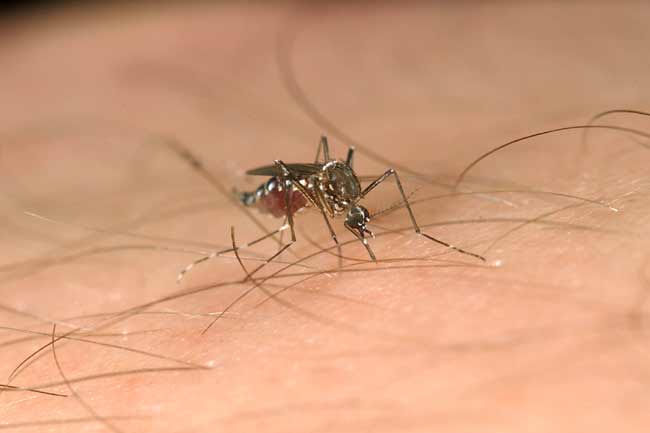How Mosquitoes Walk on Water and Up Walls

Mosquitoes may be annoying, disease-carrying, blood-sucking pests, but they have a pair of talents that no other animal has: They can both walk up walls and walk on water, and a new study reveals exactly how they manage these circus feats.
Other insects, such as flies, can also adeptly scale walls and upside-down surfaces, but the moment that they alight on a water surface, they're goners. Still another group of insects, particularly water striders, can skate across a pond with ease, but if they were to try to walk up a wall, they'd fall flat on their backs.
But mosquitoes have the ability to stand on both surfaces; walls and ceilings are a good place to escape predators, while ponds and other water bodies are where mosquitoes lay their eggs.
Many insects evolved from the water, notes MIT mathematician David Hu, who has studied water walkers extensively, but mosquitoes continue to spend part of their life cycle in the water.
"They're born underwater, and they have a larval stage, so they have to lay eggs on the water surface," Hu, who was not involved with the new study, told LiveScience.
So how does a mosquito remain stable on such different surfaces?
Hairs and grooves
Sign up for the Live Science daily newsletter now
Get the world’s most fascinating discoveries delivered straight to your inbox.
A mosquito has special foot pads, similar to those of a fly, which have stiff bristle-like structures, called setae, that help it stick to vertical and upside-down surfaces with ease.
But setae are useless on water.
Water striders, which float atop the water waiting for other insects to fall in and provide a tasty snack, are the water-walking experts of the animal kingdom. Tiny hairs cover every inch of their legs and make it difficult for water to penetrate.
Mosquitoes lack these hairs, but they do have small grooves containing pockets of air covering their legs. The surface tension of water makes it difficult for the water to seep into the grooves, keeping the mosquitoes high and dry.
"The smaller the grooves are, the more difficult it is for water to penetrate," Hu said.
The new study, published in the July issue of the journal Physical Review E, found that a single mosquito leg can support 23 times the mosquito's body weight.
Water dimples
When water striders or mosquitoes stand on water, their feet create a dimple in the water, and the surface tension of the water keeps them afloat.
"[The water] tries to minimize its surface contact area with the air," Hu said. "That means it tends to act like a trampoline," curving downward and supporting the weight of the insect.
Unfortunately the same principle makes it impossible for large animals such as humans to stand on water. The bigger an object, or animal, is, the smaller its surface area is with respect to its weight, so there is less surface available to take advantage of the surface tension of water to support its weight.
"If you calculate the size of the feet you need to have to support your weight on water, it's something like a kilometer," Hu said.
So, as you know, if you try to step off the edge of the pool into the water, you're just going to make a big splash.
"We're so large that basically surface tension is meaningless to us," Hu said. "But when you're [a small insect], it means everything."

Andrea Thompson is an associate editor at Scientific American, where she covers sustainability, energy and the environment. Prior to that, she was a senior writer covering climate science at Climate Central and a reporter and editor at Live Science, where she primarily covered Earth science and the environment. She holds a graduate degree in science health and environmental reporting from New York University, as well as a bachelor of science and and masters of science in atmospheric chemistry from the Georgia Institute of Technology.










